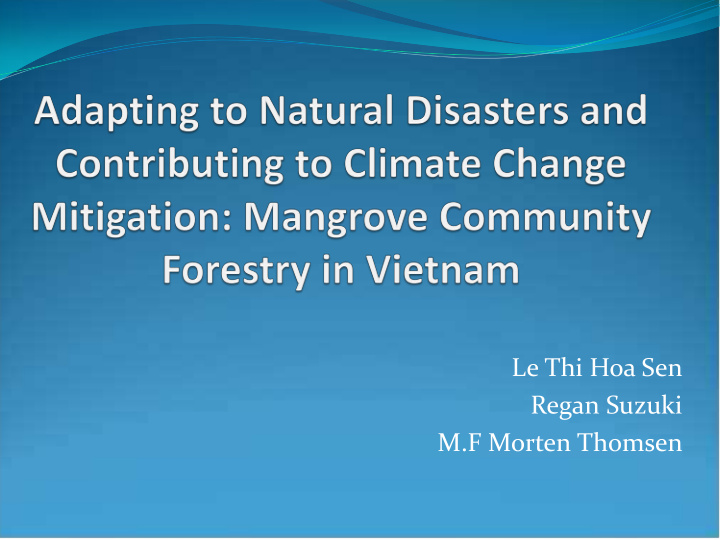



Le Thi Hoa Sen Regan Suzuki M.F Morten Thomsen
1. Background
Background (cont.) Total area: 11,116.3km 2 Population: 8424 inhabitants 2074 households 10 villages
2. Climate Change and Perceived Impacts in Vietnam and in Da Loc Growing intensity of storm, typhoons- Damrey typhoon 2005 More extreme and unpredictable weather conditions More cold fronts Abnormal rainfall
3. Climate Change Vulnerabilities Exposure and sensitivity - Along coastline - High population concentration - Low elevation area: 2-3m above sea level, many properties 1m below sea level - High poverty rate: 23.5% - Out migration of young labour
4. Timeline 1982- The Government begins to construct a sea dike in Da Loc commune. 1989 - The Japanese Red Cross and partners launch a mangrove afforestation project on 350 hectares of land. Pre-2005- Only 15 to 20% of the mangroves from the Red Cross project survive. 2005 - Typhoon Damrey strikes, causing widespread destruction to the commune, damaging the sea dike 2006 The Government, CARE International, and Da Loc citizens establish the Community Based Mangrove Management Board (CBMMB).
Timeline (cont.) 2007 −2008 CARE- leads establish a mangrove nursery, spanning approximately 150 hectares: survival rate ~ 70-80% 2009 The Government signs a five-year agreement for Community-Based Forest Management 2010 This model was replicated to other communes: total of approximately 500 hectares .
5. Factors contribute to the successful of the project Local people awareness Participation of local people in the project: community organisations and individuals of all ages Make use local knowledge: selecting seedlings, planting, caring and managing Social activities: camping, integration mangrove protection issues in social contests/ festivals Involvement of government in allocating rights for the community Benefits of the mangroves to the community
6. Participation and local knowledge Selection of local seeds/ seedlings Campain
Local knowledge in planting mangroves and removing barnacles
Participation of youth union in caring mangroves: removing barnacles and wastes
Organising contests at schools for children to learn about roles of mangroves and how to protect mangroves
Management mechanism: -Rights to manage (5 years duration) - forming management regulations, MB -Village representative do patrolling: all villagers involving in management - Every 3 months allow people to collect aquatic resources: fishes, crabs, mollusks, shrimp,… - Contribute 5% of harvest for MB Community benefits: - Collecting aquatic resources -Bee keeping -Duck keeping - Be protected from disasters -Reduced waste dispose into the community -Better environment
6. Constraints Short term rights over the forest management Related policies on coastal land use Development of aquaculture activities in the area Long term management, protection of the forest
7. Key lessons Long term official recognition of community management rights over the mangroves Equitable benefit-sharing mechanisms are ensured and participatory decision-making processes are incorporated for the well-being of vulnerable community members Trade-offs have emerged that may threaten the project- need careful analysis on costs and benefits of both adaptation and mitigation action Locally adapted knowledge and awareness can be highly beneficial to projects
Thank you
Recommend
More recommend